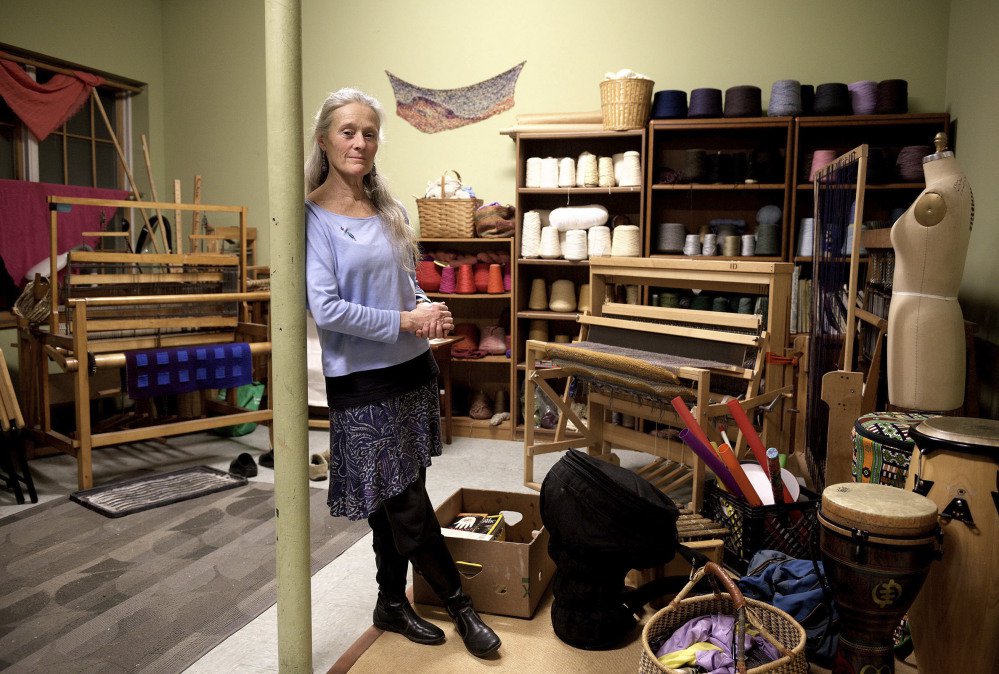CHELSEA, Vt. — In 1995, Tracy Penfield began volunteering at SafeLine, the Chelsea-based domestic and sexual violence crisis hotline.
A decade earlier, Penfield had left a destructive marriage out West to return home to the Upper Valley, where she grew up. The stories she heard on the hotline floored her.
“I tell you, it was like being thrown into the front lines of domestic and sexual violence. I was humbled and awed by what people told me,” Penfield said.
She understood then that she carried her own scars from her marriage, and she realized how valuable it could be to talk to someone without judgment – and to be heard.
As a dancer and weaver, she also recognized the role that the nonverbal communication of the performing and visual arts could play in helping people who have endured abuse begin to recover, which is what led her in 2000 to found SafeArt, the nonprofit organization in Chelsea that offers workshops, classes and one-on-one counseling at no charge to people who need help.
BOOK AS A GUIDE
Now Penfield has a book out, A Curriculum of Courage: Making SafeArt, that explores how teachers, health professionals and individuals can use some of the techniques that she and other SafeArt personnel have devised to help people who have endured abuse.
The book covers a lot of ground, including the principles that SafeArt espouses, how to facilitate sessions and workshops, how trauma affects the brain and how people can use meditation, writing, dance and movement, the visual arts and theater to express what they’re feeling.
“It’s different from a step-by-step curriculum. I didn’t want it to be an academic tome,” Penfield said in an interview in her office.
She is not a psychologist, she makes clear, but she has done specific training over the years to work on issues of abuse. She envisions the book as a kind of cookbook: a teacher could dip into whatever section she wants to and adapt the advice to suit her classroom’s needs.
Over the years she has given presentations to elementary, middle and high school students in the Upper Valley because she would like to reach as many people as possible.
NO EXPECTATIONS
“When we go into a classroom we get everybody,” Penfield said.
The point, she said, is to show and tell people that if and when they seek out SafeArt they can expect an atmosphere of “nonjudgment and non-expectation.”
Mary Chin, who taught art at Oxbow Union High School, recalled that a week’s residency by the SafeArt staff showed students that they were not alone in experiencing abuse, trauma or even just the normal adolescent feelings of isolation.
“The kids sat in a circle and were asked, What was this like for you? The kids said I thought I was the only one and now I know that I’m not,” Chin said in a phone interview. Students understood each other better, and that also helped to lessen any tensions between them, she added.
But it is not necessary for people to talk about what brought them to Safe Art if they do not wish to, Penfield said.
She remembered doing movement therapy with a woman whose gestures and way of holding herself were a clear metaphor for whatever it was that she’d lived through.
“She never told me what had happened to her and I didn’t ask her to,” Penfield said. The objective was to support “the growth and healing of an individual, through non-verbal means.”
Kim Donnell, a Hanover resident who said she has experienced trauma, has been coming to SafeArt for nearly two years. She’s attended workshops on writing haiku and working with horses that, she said, have “helped me get on track with movement and body work.”
“I was like a statue until I met Tracy,” Donnell said.
Raymond Chin, a clinical psychologist who practices in Hanover and works with children and adolescents, (and who is married to Mary Chin) worked with Penfield on the chapter on trauma and the brain.
Trauma is not in the event itself, he said, but is stored in the nervous system. In adults that can take the form of, among other manifestations, sleeplessness, shaking and anxiety; in children that can take the form of sleep and appetite disturbance, irritability, acting out in odd ways, incontinence and hyper vigilance.
NON-VERBAL OPTION
While talk therapy is appropriate for many people, adults in particular, it often retraumatizes children because it forces them to relive the trauma.
Further, Chin said, “sometimes the trauma will happen when children have very little verbal skills. To try to have them verbalize it would be developmentally inappropriate,” he said in a phone interview.
This is where the visual and performing arts, and movement, can come in.
“You can take something that is very stressful and not only acknowledge it, but also use it as a driving force to create. People who are then able to create feel alive and, if you will, powerful,” Chin added.
When past abuse or mental health issues are not addressed, Penfield said, they tend to “get stuck or buried. It’s better to get it out into the open than to let it fester in the dark, where it likes to be.”
Send questions/comments to the editors.



Success. Please wait for the page to reload. If the page does not reload within 5 seconds, please refresh the page.
Enter your email and password to access comments.
Hi, to comment on stories you must . This profile is in addition to your subscription and website login.
Already have a commenting profile? .
Invalid username/password.
Please check your email to confirm and complete your registration.
Only subscribers are eligible to post comments. Please subscribe or login first for digital access. Here’s why.
Use the form below to reset your password. When you've submitted your account email, we will send an email with a reset code.